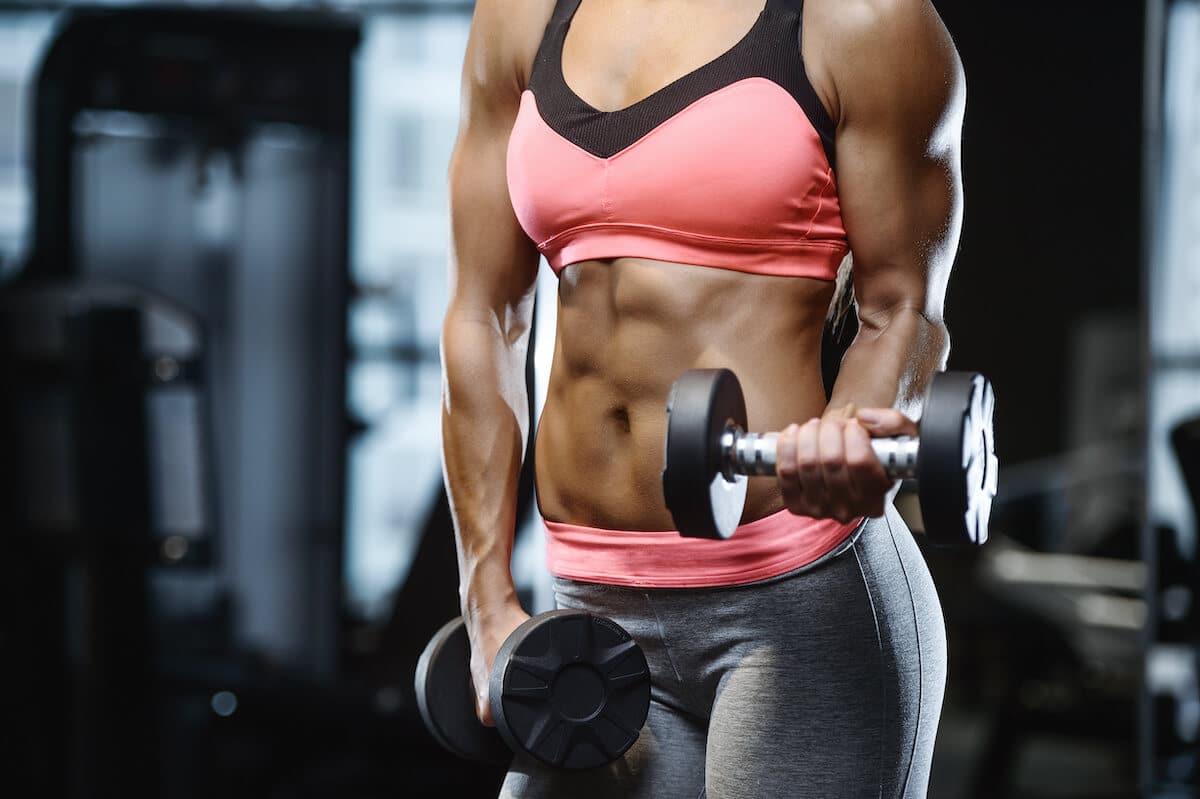
01 Oct Lean Muscle Mass: Why You Need It and How to Get It
If you’re any kind of athlete, you probably spend time focusing on building lean muscle mass — and rightly so as it supports your athletic performance. But regardless of your health goals or fitness level, lean muscle is important for general health and wellness at every age.
Why is it so important? Let’s look at what lean muscle mass is, why you need it, and how to go about building it. It’s truly worth the effort.
What Is Lean Muscle?
The truth is there’s actually no such thing as “lean muscle” as opposed to any other kind of muscle. In fact, all muscle is lean as it contains no fat.
Muscle tissue is built using protein. It’s composed of long muscle fibers that lengthen or contract as you move different parts of your body. Your body contains three types of muscle:
- Smooth muscle: This surrounds your organs and controls the involuntary movements of your body, like breathing and digesting food.
- Cardiac muscle: This helps the heart to pump blood around your body, also without you having to think about it.
- Skeletal muscle: This is attached to your bones and you use it for voluntary movements like walking, talking, and smiling. It’s the only type of muscle that you can purposely grow and develop through resistance training.
Whether your body looks lean or not depends on how much fat you’re carrying along with the skeletal muscle, so what we’re really talking about here is body composition.
What Is Body Composition?
To understand how body composition is measured, let’s look at a couple of related terms.
Lean Body Mass
Lean body mass (LBM) is made up of the combined weight of your bones, muscles, organs, ligaments, and tendons, plus all the water in your body. Basically, it includes everything except fat, and hence it’s also known as fat-free mass.
Fat Mass
There are two types of fat:
- Essential fat: This is an intrinsic part of your organs and bone marrow. It’s critical for the healthy functioning of your body and is included in your LBM.
- Storage fat: Otherwise known as fat mass or adipose tissue, this is the body fat that accumulates around your body, including under your skin and around your organs. This varies throughout your life and it’s what you may be trying to reduce if your goal is weight loss or if you want to look more toned.
Body Composition
Body composition is usually measured as fat vs fat-free mass (or LBM). The lower your body fat percentage — in other words, the less fat you’re carrying — the more toned you are likely to look.
Although this is not the same thing as body mass index (BMI) — which measures your weight to height ratio — when you know both your body fat percentage and your BMI, you can get a good idea of your state of health and from there decide on your fitness goals.
Should I Use a Lean Body Mass Calculator?

Online calculators and lean body mass estimators can work out lean body mass based on average statistics. Bear in mind though that their results are indeed averages and not particular to your condition.
If you really want to know what’s happening with your body composition, you need to find out your body fat percentage. You (or rather a personal trainer, doctor, or other fitness expert) can do this using a method like skinfold assessment, biometrical impedance analysis, or hydrostatic weighing (which is the most accurate).
Once you have your body fat percentage, you subtract that from your total body weight, and you’ll have your lean body mass.
What does that mean in terms of fitness or wellness goals?
If your lean body mass stays the same but your overall body weight reduces, you’re losing fat. If your lean body mass goes up but your overall weight stays the same, you’re probably building muscle.
However, if your lean body mass is getting less, you’re probably losing muscle and/or bone density, neither of which is a good thing. If that’s the case, we’ve outlined the three aspects of muscle building — resistance training, nutrition, and rest and recovery — in a subsequent section for you to consider.
It’s also important to note that you need a certain amount of body fat for your body to function properly, especially when it comes to your immune system and hormone production. Depending on age, women need 14-31% and men need 8-25% body fat. Fall below this and you may find that your health suffers.
Why Is Lean Muscle Mass Good for You?

Apart from the aesthetics of looking “ripped,” lean muscle mass has many other benefits. These are just some of them:
- Muscle helps to strengthen your core, protect your tendons and ligaments, and improve your coordination, lessening the chance of injury. This is just as important while carrying out everyday tasks as it is during a high-intensity workout routine or a competitive athletic event when you need to perform at your best.
- Lean muscle mass boosts your basal metabolic rate and therefore helps you burn fat, even while you’re sleeping. Too much body fat can lead to other issues like cardiovascular disease, diabetes, and joint problems.
- Building muscle helps to counteract age-related muscle loss, reducing the chances of falling or otherwise injuring yourself.
- Building muscle also strengthens your bones, which lowers your risk of arthritis and osteoporosis as you get older and means you’re less likely to break a bone if you do fall.
- Lean muscle also helps to manage your blood sugar, especially if you’re at risk of Type 2 diabetes.
Last, but by no means least, feeling physically strong and toned is likely to give you confidence in other areas of your life too.
How to Reduce Body Fat Percentage and Build Lean Muscle Mass

Trimming your body fat and building lean muscle mass is mostly a function of three factors:
- Resistance training
- Nutrition
- Rest and recovery
Let’s look at each of these in more detail.
Resistance Exercise
Otherwise known as strength training, resistance training breaks down the fibers in your muscles, and as your body repairs the fibers, your muscles gain strength and mass. If you do this repetitively, challenging your muscles more each time, you’ll see ever greater muscle gains.
As any personal trainer will tell you, whether you’re deadlifting barbells, dumbbells, or kettlebells, doing push-ups or burpees, or putting your body through its paces in a high-intensity interval training (HIIT) circuit, the key is to keep going until you can’t anymore.
In fact, when it comes to weightlifting, research shows that if you want to gain muscle mass, so long as you’re working to failure, it doesn’t matter whether you choose low reps and high load, or high reps and low load. If you want to build strength though, high load and low reps are your best choice.
Either way, you do need to rest for between one minute and three minutes (the research differs) in between sets to give your muscles a chance to recover.
If you’re not looking to bulk up but simply tone, adding some light weights to your regular cardio exercise routine — whether that’s running, swimming, or Zumba class — is very effective, as is holding that lunge, squat, or power yoga pose as long as you can.
Should You Do Cardio as Well?
Cardio definitely has a place since aerobic exercise helps to burn fat and to keep your body healthy and it does, to an extent, help with muscle growth. If your goal is to build bulk though, bear in mind that cardio also uses energy that you may need to lift weights. There’s a reason that runners are often less bulky. You may want to consider sticking to two or three cardio workouts a week of fewer than 45 minutes each or get your cardio in with a HIIT routine.
Nutrition
If your goal is to build lean muscle, nutrition is an essential part of the equation.
If you’re wondering how many calories to eat for fat loss, the answer is to reduce your daily calorie intake to just below the calories you need — without reducing them so far that you don’t have enough energy for your workout, which can lead to muscle breakdown.
While you’re deciding what to eat, bear in mind that you need all the macronutrients for your body to function optimally. That means you need to include protein, fat, and carbohydrates in your meal plan.
Protein
In a nutshell, if you want to build muscle, you need to make sure you’re getting enough protein.
When you consume protein, your digestive system breaks it down into essential amino acids, which are the building blocks for every part of your body structure, including muscle. These amino acids are released into your blood and then used to build your muscle or repair it after a workout.
Unless you consume enough protein to provide you with those amino acids, it’s impossible to gain lean muscle mass. As a bonus, protein also helps you to feel full so it’s easier to control your appetite if you’re counting calories.
The average, moderately active person needs 0.8 grams of protein per kilogram of body weight per day. However, if you’re an athlete or bodybuilder involved in high-intensity resistance training, you may need up to 2 grams per kilogram.
It’s also worth noting that as you get older, you tend to lose muscle mass and strength, and it becomes more difficult to build new muscle. It’s therefore important to keep your protein intake on the higher side — around 1.2 to 1.5 grams per kilogram of body weight — to make sure you maintain the muscle you have.
That protein can come from animal products like meat, chicken, fish, or dairy or from plant-based protein like soy, hemp, chia, or legumes. It can also come from high-quality supplements.
Carbs
Avoid highly refined carbohydrates like white wheat flour — which can potentially cause intolerance or inflammation issues — and stick to healthy complex carbs that are also packed with vitamins and minerals. For example, quinoa is an excellent source of both protein and carbs, and sweet potatoes are full of nutrients, especially potassium, which protects lean muscle.
Fats
If you’re eating meat, fish, eggs, or dairy products, you’re probably getting a good dose of fats at the same time. And there’s no need to be afraid of healthy fats — you need them for your body to function. If you’re adding fat to your meal though, prioritize types that support your health, like olive, coconut, or avocado oil.
The Role of Supplements

If you’re very physically active, even if you focus on a high-protein diet and include superfoods like quinoa, it may be a challenge to eat enough whole foods. Supplementation can help to fill the gap here.
If you’re looking to build lean muscle and reduce fat mass, you may want to choose a protein supplement like whey protein isolate rather than whey protein concentrate as whey isolate is lower in fat and carbs. It’s also a better choice if you’re sensitive to dairy as it has very low lactose content.
Whey protein can give you a quick boost of energy and amino acids when you need it, either pre- or post-workout. Casein is better known for slow release and is generally taken at night so your body can work on building and maintaining your lean muscle while you sleep. Either of these supplements can be added to a protein shake or many other meals like soups or stews without drastically affecting the taste.
Bear in mind here that quality matters. If you’re looking for a high-quality Ingredient Optimized supplement like ioWhey Protein, you’ll find it in products like Kaged Muscle Clean Meal and Performix ioWhey.
If you’re vegan or vegetarian, pea protein can be an excellent choice. In fact, Ingredient Optimized ioPea Protein is the first pea protein scientifically proven to be more bioavailable than whey protein. That means that once it’s digested, your body can absorb and use a very high proportion of the amino acids it contains.
Rest and Recovery
As we’ve mentioned, you need to rest between sets during your workout routine.
You also need to rest in between high-intensity workouts so your body has a chance to repair your muscles, which is what helps them to grow. One way of doing that is to vary your exercise routine so you’re working on different muscle groups each day.
For example, you might do weight training that focuses on your biceps and triceps one day, then your core and legs another day, with some lower intensity exercise on days in between.
Beyond that, you need to make sure you get good quality sleep. This ensures that you have the energy and mental focus you need for your workout and the rest of your day. It also gives your body a chance to produce the growth hormones that you need to build muscle and repair any damaged muscle through protein synthesis.
A Word About Body Types
It’s worth noting that your natural body type plays a critical part in how much bulk you’ll be able to put on or how lean you’re likely to look. Your body type depends on factors like gender, genetics, and hormones, among other things.
Some body types easily gain muscle mass (and fat, so looking toned may be an issue). Others — who often have a faster metabolism — can easily keep fat off and gain strength but may struggle to bulk up as much, no matter how much they eat.
Women particularly are not naturally inclined to gain muscle mass. If that’s your goal, you’ll need to work intensively with your diet and supplements to make it happen.
Build Lean Muscle Mass to Improve Your Health
Managing your body composition to achieve a high lean body mass and healthy — not too low — fat mass is important. It helps your body function optimally and protects your health throughout your lifetime.
To achieve your ideal lean muscle mass, you need the right balance of nutrition, resistance exercise, and rest and recovery time. It takes some focus to make it all work, but it’s worth the effort. After all, doing the work to optimize your health will benefit you right now as well as in the long run.


